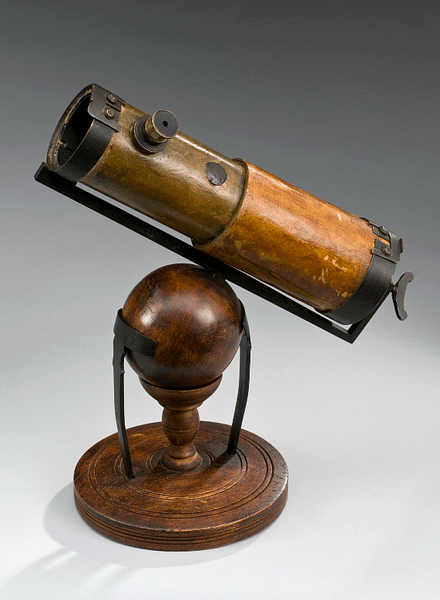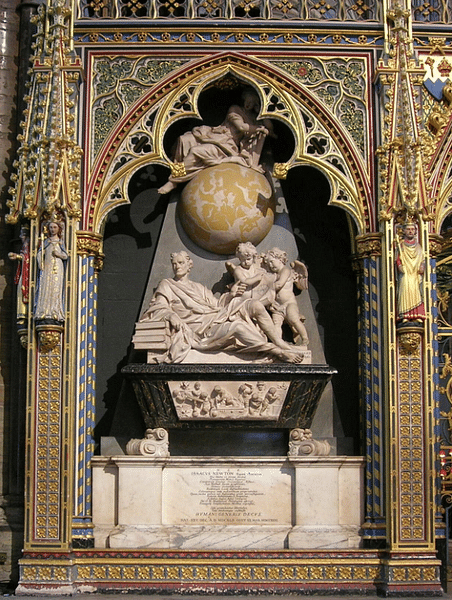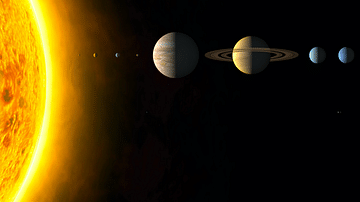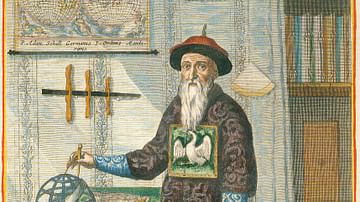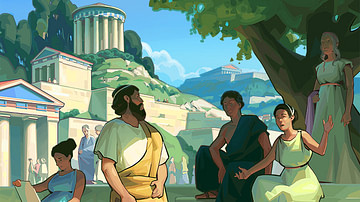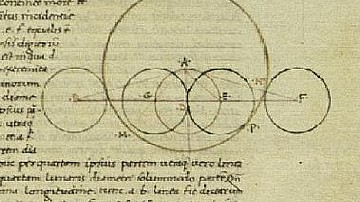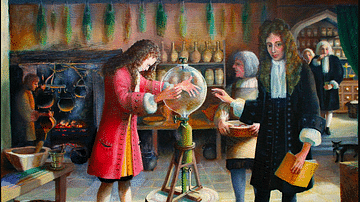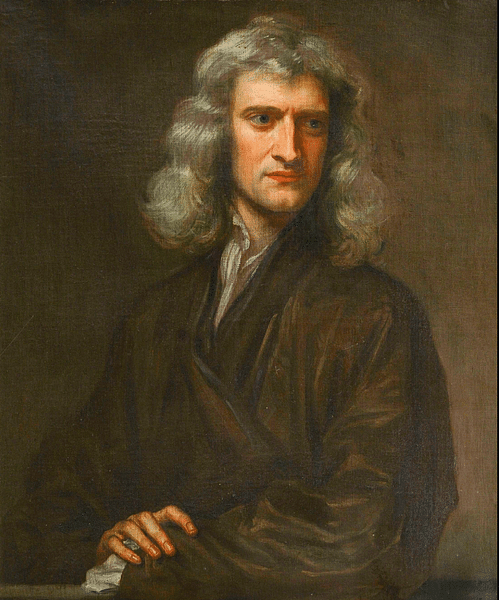
Isaac Newton (1642-1727) was an English mathematician and physicist widely regarded as the single most important figure in the Scientific Revolution for his three laws of motion and universal law of gravity. Newton's laws became a fundamental foundation of physics, while his discovery that white light is made up of a rainbow of colours revolutionised the field of optics.
Early Life
Isaac Newton was born on 25 December 1642. His family in Woolsthorpe, Lincolnshire, was of the yeomanry class, but it was clear that Isaac was destined for a career other than farming. Isaac's father died a few months before he was born, and his stepfather, a minister, died when he was 14. His mother was Hannah Ayscough, and her second husband insisted that Isaac be separated from his mother for a number of years. Some historians have read into this period of neglect the cause of Newton's notoriously prickly character and hypersensitivity to criticism later in life.
The young Isaac had a prodigious interest in all things mechanical, and he made several working models of his own, but he did not do particularly well at school. He was mischievous and once sent out into the night sky a series of candle-lit lanterns, which startled the local villagers into thinking a shower of comets was about to strike them down. An uncle of Isaac was adamant he was sent to study law at Trinity College, Cambridge, in June 1661. It was not law, though, but mathematics at which the young scholar excelled.
Isaac supplemented his orthodox education by taking private lessons with the mathematician and theologian Isaac Barrow (1630-1677). Barrow would later recommend Newton for his own soon-to-be-vacant chair at Trinity College. Newton graduated in April 1665, but any hope of a quick career launch was scuppered when there was an outbreak of the Black Death plague. Isaac was obliged to return to the family home in Woolthorpe for a year or more.
Newton's Approach to Knowledge
Isaac did not waste his year of forced seclusion as he launched into a series of scientific investigations, so much so that he described 1665 to 1666 as his "year of wonder" (Burns, 217). Newton discovered "the binomial theory, the differential and integral calculus, and the refraction of light, and he began to work out the theory of universal gravitation" (ibid). Heady stuff. Newton was determined to use all manner of methodologies and thinking, from alchemy to mechanical philosophy, in order to find out scientific truths that can be expressed mathematically. To this end, he relentlessly squirrelled away kernels of ancient and contemporary knowledge, experimentation, and even lore in a few select and very private leather-bound volumes, thus preserving his findings for later consumption when his scientific theories became clearer. As Newton himself once stated in a private letter, "If I have seen further it is by standing on the shoulders of giants" (Wootton, 341).
Newton was also a Protestant Christian (although an unorthodox one in private) and saw no conflict in his endeavours to explain why things happened the way they do in the physical world with the story of the Bible. Indeed, the imperfections of the physical world his theories proved all required, Newton said, a Creator to adjust them every now and then. Some Christians saw this as denying the perfection of the Creator, others saw it as support for having a Creator in the first place. For Newton, space was "an eminent effect of God," and "he seems to have gone so far as to later identify space with the immensity of God, so that the biblical pronouncements that 'In Him we live, and move, and have our being' (Acts 17:28) was taken quite literally" (Henry, 89).
Like many thinkers of the time, Newton was convinced that great knowledge had been gained and then lost over the centuries and so careful research of past intellectual endeavours was essential in order to recapture this lost wisdom (known as prisca sapientia). This belief in a lost or secret knowledge – a peculiar eccentricity for a scientist – may also explain why Newton was notoriously reticent to publish his own discoveries. He seemed to relish secrecy, just as was the tradition of the great alchemists of the Middle Ages. Fortunately for the progress of humanity, Newton did eventually make his ground-breaking research public.
Newton's Spectrum of Light
Newton did not find the esteemed Royal Society very receptive to his new ideas, particularly on optics, and so he got his foot in the door of that institution by designing a reflective telescope in 1668. This type of telescope used a curved mirror made of a tin and copper alloy, which improved the clarity of the image seen by reducing chromatic aberration, that is, when all colours fail to converge in a single point (a problem of glass lenses at the time). Newton's telescope had a magnification of 40 times and was ten times shorter than the standard refracting telescope of the same strength would have been. The Royal Society was hooked, and Newton was elected to that learned body in 1672; he then submitted his research on optics, which had, in fact, made his super-duper telescope possible.
Between 1666 and 1668, Newton had conducted optical experiments where he captured a narrow beam of light through an aperture, which was then projected onto a wall in a dark room. The light was made to shine through a prism. Others had done this sort of thing before, but, significantly, Newton put his prism near the hole and far from the wall on which was projected a block of rainbow colours: red, orange, yellow, green, blue, indigo, and violet. Even more crucial – in what he called his experimentum crucis – Newton then had various colour beams of the split white light go through a second prism, and these left that second prism the same colour as they entered, i.e. they could not be split further. Newton was thus able to develop a new theory of light, which was that white light is made up of a spectrum of different colours, each with a different angle of refraction, just like a rainbow one could see in the sky after a shower of rain. In the rainbow in the sky, drops of water function as a prism, that is, the white light is refracted. Newton also discovered that in the tiny airspace between a lens and a sheet of glass, coloured concentric rings can be seen, and these are now called Newton's rings.
Newton's idea of heterogeneous light, published in Philosophical Transactions in 1672, went directly against the standard theory of the time, which was the inverse of Newton's. Champions of the standard theory included Robert Hooke (1635-1703), who dismissed Newton's theory and later even accused him of plagiarism (without foundation). Newton, who was "of somewhat paranoid temperament" (Burns, 73) and "socially dysfunctional" (Jardine, 36), promptly withdrew from the Royal Society and would not even accept its presidency until Hooke had departed this earth. In 1704, Newton finally published his work on light in detail in his Optics. It took some time for Newton's theory to become widely accepted, but it is now a cornerstone of the science of optics.
Newton's Law of Gravity
The German astronomer Johannes Kepler created the most accurate yet system of planetary astronomy, with the heavenly bodies moving in elliptical orbits around the Sun and not the traditional model of perfect circles as proposed by thinkers from Claudius Ptolemy (c. 100 to c. 170) to Nicolaus Copernicus (1473-1543). The discovery that the planets increased their speed as they drew closer to the Sun was essential for Newton to build his own work upon. Newton's law of gravity would provide the cause for Kepler's keen observations of elliptical planetary motions. Encouraged, both with words and money, by his good friend Edmund Halley (1656-1742), Newton finally presented his theory of gravity in Mathematical Principles of Natural Philosophy (Philosophiae Naturalis Principia Mathematica), published in 1687.
The effects of gravity have been known since antiquity. Ancient thinkers formed theories as to why objects fell to the ground, the most common being that this was because Earth was the very centre of the universe and so some mysterious force attracted all objects to the central point. Similarly, thinkers like Galileo Galilei (1564-1642) had pondered what kind of force was responsible for the Sun seemingly pulling orbiting planets more speedily to its centre the closer they got to it. Magnetism was often suggested as the answer, but many thinkers remained unconvinced.
An apple may not have actually fallen from a branch and hit Newton on the head, but it does seem that his observation of fruit falling set him pondering what force was involved and how to measure it. Newton had also noticed many other 'attractions' and 'repulsions' between many other objects and substances, and so he began to formulate a theory that could measure such phenomena and finally bring together (or at least reconcile) two ancient but often opposing strands of human thought: mechanics and mathematics.
In his Principia, Newton put forward his theory of universal gravitation, but first, he presented a system of mathematical laws, which became known as 'Newton's laws of motion', here summarised by W. E. Burns:
That there is an attractive force between bodies that varies with the inverse square of the distance between them – and Newton's three laws of motion – 1. a body at rest or in motion in a straight path will tend to stay in that state, 2. a change of motion in a body varies with the force impressed, and 3. each action has an equal and opposite reaction.
(218)
Newton then presented his theory of gravity:
That between any two bodies in the universe there exists a force directly proportional to the product of the masses of the two bodies and inversely proportional to the square of their distance.
(Burns, 245)
Newton's theory of gravity was universal because it applied to everything from spinning planets to the movement of comets to the tides of the sea to that apocryphal apple dropping from a tree. The law of gravity (actually called a 'law' by Newton only in his later Optics) applied equally to terrestrial affairs and to the heavens. Newton could now make accurate predictions of the effects of gravity. This was a new science. Of course, not everyone immediately adopted Newton's theories. The mechanical philosophers and the Cartesian followers of René Descartes (1596-1650), for example, could not accept that one physical body can affect another body without something, a third element, touching the two. Put simply, gravity was rather mysterious, since nobody, not even Newton, knew where it came from, why it exists, and who or what ensures its persistence. Contemplation on this fact and the inference that these forces act without any consideration of humanity led in some ways to a disenchantment regarding a new and pitiless world, at least for those who did not believe that a god of some kind was behind it all.
Recognition: The Greatest Scientist
Newton's work on gravity was ultimately well received, particularly in England, and he was made a fellow of Trinity College in 1687. Two years later, Newton became the Lucasian Professor of Mathematics there. A circle of devoted international followers sprang up around Newton, including the Swiss mathematician Nicolas Fatio de Duillier (1664-1753), who became very close to him. From 1688, Newton became ambitious to forge a political career. The scientist had hoped to move to London but suffered a nervous breakdown in 1693, perhaps because of the end of his relationship with Fatio de Duillier but certainly made worse by his chronic insomnia and possibly even a consequence of mercury poisoning, a key ingredient of Newton's experiments in alchemy. Recovered by 1696, Newton was made the warden of the royal mint in the Tower of London, which carried with it both prestige and a handsome salary. Newton, taking a hands-on approach which had not been required for what was, in effect, an honorary position, impressed his employers so much that he was made the mint master in 1699. He performed the role with remarkable dedication for the next 28 years, much to the chagrin of the countless counterfeiters he identified (who were then invariably hanged).
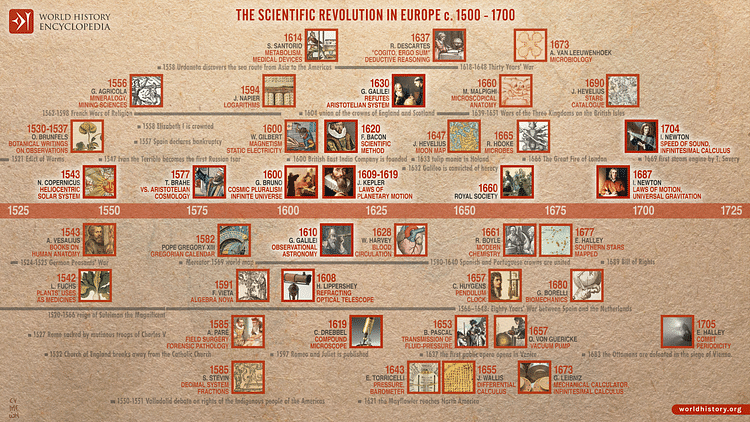
It was also in 1699 that Newton was appointed a member of the French Royal Academy of Sciences, the first foreigner to gain entry. In 1703, he was elected President of the Royal Society, and he used his position to skew the society's endeavours much more towards practical experimentation (as opposed to merely reading the academic papers of others) throughout his tenure, which ended in 1727. Less admirable was his ongoing feud with the German mathematician Gottfried Wilhelm Leibniz, which significantly held back mathematics in Britain. Newton accused Leibniz of plagiarising his work on the calculus (a mathematical tool for calculating curves and their areas). In reality, both men had developed the calculus independently, and although most historians consider Newton to have got there first, Leibniz's version was superior. Newton was knighted by Anne, Queen of Great Britain (r. 1702-1714) in 1705, probably more for his service in the royal mint than his tremendous contribution to science, but, nevertheless, it was a memorable moment for all scientists past and present since he was the first to be so honoured.
Death & Legacy
Newton was famous in his own lifetime for his discoveries, as we have seen with his various appointments to prestigious institutions at home and abroad. Rather oddly for a man so associated with science, Newton spent his final years studying biblical prophecies, an area he believed was just as valid as scientific experimentation. Sir Isaac Newton died of kidney failure on 20 March 1727; he was 84 years old. He had never married and left no children. Newton was given a state funeral and buried in Westminster Abbey. Alexander Pope provided the memorable epitaph:
Nature and Nature's Laws lay hid by Night:
GOD said, Let Newton be! And all was Light.
(Wootton, 361)
Newton, in one of those statements he frequently made where one wonders if he is being genuinely modest, remarked upon his career and discoveries in the following terms:
I don't know what I may seem to the world but, as to myself, I seem to have been only like a boy playing on the sea-shore, and diverting myself in now and then finding a smoother pebble or a prettier shell than ordinary, whilst the great ocean of truth lay all undiscovered before me. (Gleick, 4)
There would be many more breakthroughs in science after Newton, but nothing as revolutionary as his work until the development in the 20th century of relativity and quantum physics.
There developed a definite movement, known as Newtonianism, which pushed the idea that scientific knowledge should be presented as a series of mathematical laws which could predict tendencies of motion in relation to hypothetical accelerative forces. In addition, because Newton's research was so complex and inaccessible to the majority, a great number of writers sprang up who simplified Newton's work so that it could be understood by the reasonably well-educated. Newtonianism gradually spread across Europe to become the dominant approach in universities and amongst intellectuals. Newton's approach to knowledge, spread to new minds by such thinkers as Voltaire (1694-1778) in his Elements of Newton's Philosophy (1738), was an important part of the Enlightenment movement, where the improvement of the human condition became the ultimate goal of philosophy and science, despite Newton having split those two disciplines apart forever. Even that great modern genius Albert Einstein (1879-1955), with his new theory of relativity, could not overthrow Newtonianism but only extend it to new and bold horizons. As Einstein once said of Newton: "He stands before us strong, certain, and alone" (Gleick, 9).

